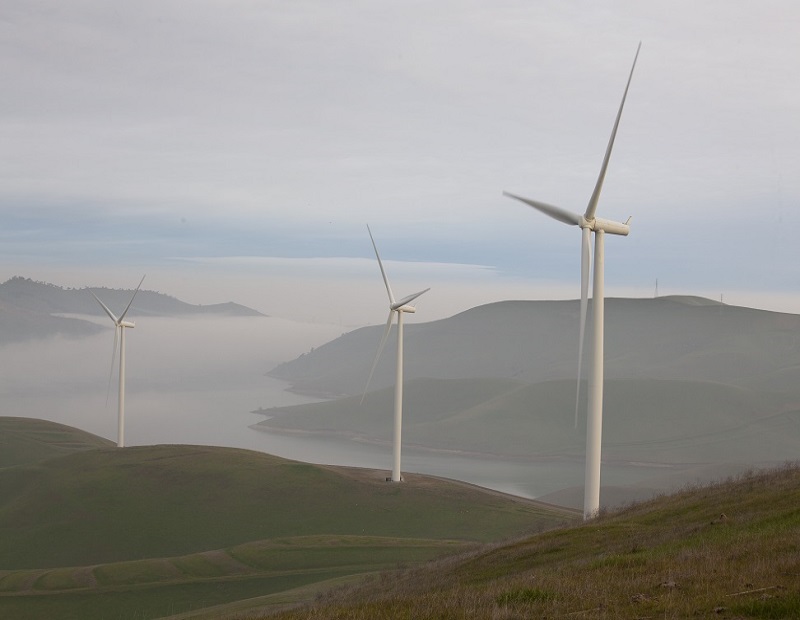The ABCs of PPAs
Corporate customers weigh the pros and cons of greening their portfolios with power purchase agreements.

Golden Hills Wind Energy Center, Altamont, Calif. Kaiser Permanente has a long-term PPA with the facility’s operator, NextEra Energy Resources.
Corporations burdened with large electricity expenditures are in the vanguard of efforts to seek low-cost solutions. That’s one reason more and more of them are choosing to enter into power purchase agreements (PPAs). A single statistic illustrates just how rapidly that preference has increased. In 2015, PPAs provided than one percent of the renewable energy sourced by the RE100, the global collaborative of companies committed to adopting entirely renewable energy sources. That figure ballooned to 20 percent in 2016, reports ScottMadden, a Raleigh, N.C.-based management consulting firm.
The appeal of PPAs rests on three main factors, said Paul Quinlan, clean tech manager for ScottMadden. The first is the push to adopt sustainable practices, particularly the use of renewable energy, he said. Limitations on procuring renewable energy directly from utility companies have led to a search for alternatives, like PPAs, Quinlan explained.
The second factor is price certainty, which for long-term PPAs has been at or below grid parity for electricity purchasing. “Third, renewable energy attributes, such as additionality and locality, are important in assessing a company’s overall sustainability portfolio,” Quinlan said. “And these attributes may drive a company toward a power purchase agreement. Combined, these three factors offer a solution in the quest for low-cost, clean energy.”
Identifying PPA Users
Who’s using PPAs? Those leveraging the trend include “everyone from Fortune 500 (companies) to your neighbor down the street,” reported Katie Treadway, head of regulatory affairs for One Energy, a wind power provider headquartered in Findlay, Ohio. “They are entering into PPAs to be able to capture the environmental and cost benefit of renewables without having to pay high upfront costs that they may not be able to afford.”
Large corporations, and particularly multinational corporations, as well as those organizations that have sustainability goals, such as RE 100 companies, are most likely to choose PPAs, said Alanya Schofield, senior director, strategy consulting and new products at E Source, a Boulder, Colo.-based energy research and advisory company.
This year, Microsoft inked the largest solar power deal in U.S. history in an agreement to purchase 315 megawatts from a project in Virginia, bringing the company’s total to 1.2 gigawatts of renewable energy under contract, Quinlan reported. “With the increase in support from organizations such as RMI, BRC, Renewable Energy Buyers Alliance and RE 100, smaller corporations are able to follow these leaders,” he said.
In response to the burgeoning interest in PPAs, utilities are increasingly developing what are termed “green tariffs” to provide larger customers both more renewable energy and locked-in price certainty, Schofield said. “The trend of a growing number of utilities offering green tariffs is definitely being driven by evolving customer desires and the market trend of an increased focus on PPAs,” she added.
Pros and Cons
PPAs have both upsides and downsides. In addition to the pros already cited, “PPAs also are typically service agreements instead of leases under GAAP,” Treadway said. “As a result, if a system is being installed at a business, the generation assets do not show up as depreciating assets on the company’s balance sheet.” For many firms, there’s also branding value in entering long-term PPAs, Quinlan said.
In a white paper earlier this year, Salesforce reported that its ability to execute PPAs has been limited, and the company generally steers toward virtual PPAs, also known as VPPAs. The prime reasons for this decision, Salesforce reported, is that its energy use is dispersed across myriad facilities, many in regulated markets where direct access is denied.
Second, the company doesn’t own its offices or data centers, is typically one tenant among many and doesn’t control the retail electricity supply. As a result, it would have to work through its lessors to enter into a PPA on its behalf. “However, because this provides opportunity to increase our positive environmental impact, Salesforce does dedicate significant time to working with lessors,” the authors wrote.
Among the cons are that PPAs can be complex from a financial and contractual standpoint, Schofield said. “Sometimes, they have the potential for financial risk depending on the terms,” she noted. “It’s important to be aware of the risks and nuances of the contract.”
Another negative is that long-term PPAs carry the potential risk of locking into a high price in a declining market, Quinlan said. Though generally thought to be a short-term issue over the length of the contract, it remains a limiting factor.
If the PPA is virtual, the pricing can be considered a price hedge and be subject to accounting rules. “With the upside gains being in the long-term, this can provide too great a hurdle for companies, especially for the first PPA contract,” Quinlan said. One more hurdle is that some regulated markets prohibit direct PPA contracts between renewable energy facilities and corporate customers, he reported.
Nevertheless, the trend will continue, Schofield predicts: “More and more customers will want both PPAs and green tariffs.”







You must be logged in to post a comment.